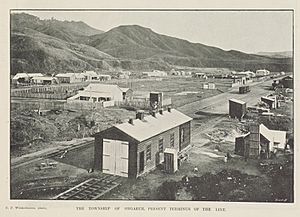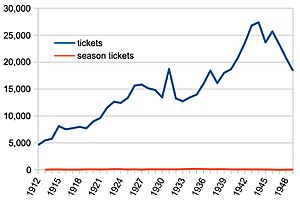Ongarue railway station facts for kids
Quick facts for kids
Ongarue railway station
|
|||||||||||
|---|---|---|---|---|---|---|---|---|---|---|---|

Ongarue railway station November 1902
|
|||||||||||
| Location | New Zealand | ||||||||||
| Coordinates | 38°42′57″S 175°16′56″E / 38.715787°S 175.282316°E | ||||||||||
| Elevation | 193 m (633 ft) | ||||||||||
| Line(s) | North Island Main Trunk | ||||||||||
| Distance | Wellington 420.68 km (261.40 mi) | ||||||||||
| History | |||||||||||
| Opened | 24 August 1901 | ||||||||||
| Closed | Before 12/1975 | ||||||||||
| Electrified | June 1988 | ||||||||||
| Traffic | |||||||||||
| Passengers (1944) | 27,378 | ||||||||||
| Services | |||||||||||
|
|||||||||||
The Ongarue railway station was once an important stop on the North Island Main Trunk railway line in New Zealand. It served the town of Ongarue, which was known for its sawmills.
When the station first opened in 1901, it had a different name. In 1900, it was called Kawakawa. Later, it was known as Ongaruhe before becoming Ongarue.
From 1922 to 1958, a lot of timber was transported from the station. This timber came from the Ellis and Burnand Tramway, which was connected to the station.
The station was also where the Ongarue railway disaster happened in 1923. This was a very serious train accident at the time.
How Many People Used the Station?
The number of people using Ongarue railway station changed over the years. The busiest year for passengers was 1944. In that year, over 27,000 people bought tickets to travel from Ongarue.
After 1944, the number of passengers slowly started to go down. The station eventually closed before December 1975.



